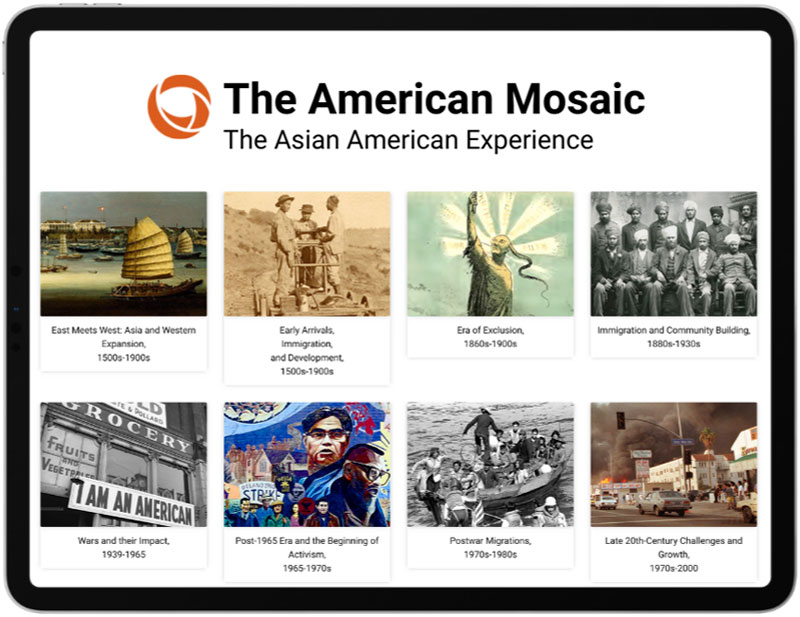SLJ Reviews ABC-CLIO's Asian American Experience Database
Part of ABC-CLIO’s The American Mosaic program, this platform offers primary sources, curriculum guides, and other tools for students and educators doing research on the Asian American experience.
The Asian American Experience
URL www.abc-clio.com/asam-experience/
Grade Level 9 Up
Cost The Asian American Experience is subscription-based with prices starting at $540 for a single-site purchase. Discount bundles are available for school districts. A free 30-day preview is available.
Content When users first open The Asian American Experience, part of ABC-CLIO’s The American Mosaic program, they will find a variety of search options. At the top, there is a classic simple search bar students can use to begin their research. There is also an option to use Advanced Search features that include a whole library of clickable options.
Users can search by type of article (i.e., biography, time line), media (i.e., photos, maps, infographics), or document (i.e., speeches, letters, magazines).
Students can also search by time period and featured topics important to that era. For example, selecting the “Era of Exclusion 1860s-1900” would include both “The Road to Exclusion, 1860-1882,” and “Defining Citizenship and Identity, 1890s-1900s.” Users can narrow the search even further, by selecting each subset individually.
After choosing the desired options, users will be taken to a results page. Within the results page, they can reassess the filters, determine how many results per page,
and choose how they would prefer the results sorted.
Search results include the resource type, the time period, and a small description before users access a link. Sources, further reading, and an MLA citation are also provided. There are standard icons above every article with the options to save, email, print, link, cite, add, listen, and translate.
A topic library is presented on the left-hand navigation, which gives users easy access to reference articles, time lines, photos, infographics, and even more related content to their current article or topic. Sometimes, clicking a topic on the left-hand navigation will send users to that article on the main browser and other times it will pop up in a new window. If it is a highlighted, related article, it will appear in a new window, but if it is another type of resource it will load on the main browser.
Another option for searching on the main page is to explore already-curated time periods and browse through corresponding topics.
With the focus on Asian American experience, this database features articles about the connections between those of Asian descent and Western countries, especially the United States. Europe is mentioned only as it impacted Asian people to in their access to resources and immigration to the U.S.
At the end of each article, a link is provided with a short biography of the author. Most of the authors are experts in their fields, though those with specific specialties offer more nuanced essays. Some pieces are better at centering Asian American perspective than others.
Student and Teacher Resources Users can find curriculum guides on the left-hand navigation, which provides key questions and research lists on various articles that can support educators within their curriculum.
Users can also create their own resource lists by clicking the Add tab on the top navigation panel. They can keep adding articles to their resource list for further evaluation. There are also a handful of resource lists already included.
An Academic Success Corner is also featured, which reviews basic research skills. This includes tutorials supporting the research process, reading skills, and note-taking skills. It also reviews topics in Information Literacy and includes an option to ask a librarian or cybrarian for support.
Each entry has a built-in citation option at the bottom of the page in addition to the citation option on the top navigation bar. Students can cite images, graphs, and more. This is extremely useful for those accessing resources and reinforces the need for citing sources. It’s an excellent addition to support student research skills and learning.
Users will find CLIOview a helpful feature that compares the statistics of a group of states across various areas, such as population, health, military, and citizenship indicators.
Educators are given examples of activities that can inspire inquiry and engagement, including sample articles, worksheets, and guiding questions.
Verdict The Asian American Experience features a vast array of articles in a multitude of formats and media. Students can easily find articles using the Topic Library. The formatting and navigation are intuitive for users, and the composition of articles is excellent. There is a comprehensive store of primary sources to enhance student analysis and critical thinking. Articles are U.S. history–centered, so language and perspective skew toward the Western Hemisphere, but still this still provides more articles on the Asian American experience than most resources. A useful and promising addition to any U.S. history collection.
Kristyn Dorfman, Friends Academy, NY
RELATED
The job outlook in 2030: Librarians will be in demand
The job outlook in 2030: Librarians will be in demand
ALREADY A SUBSCRIBER? LOG IN
We are currently offering this content for free. Sign up now to activate your personal profile, where you can save articles for future viewing






Add Comment :-
Be the first reader to comment.
Comment Policy:
Comment should not be empty !!!